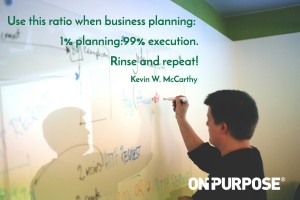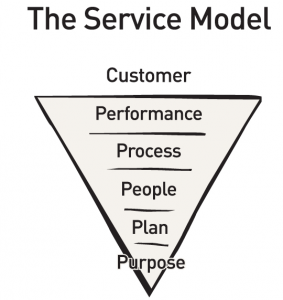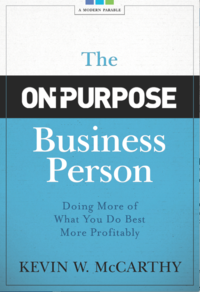Are You In The Midst of a Tough Shift (part 1)
A Tough Shift™ happens when we’re not making a smooth and peaceful transition personally, professionally, and/or corporately.
Often these transformations are due to a change in the environment beyond our control and we’re reactive.
Sometimes, however, we proactively choose to take the bull by the horns in order to improve our situation, life, or business. Either way, it is a risk that’s not easy but a decision that’s designed to hopefully improve our station or circumstance in life.
An essential element of any tough shift is the ability to have a firm grasp on reality. Hindrances such as denial, blame, and fear cloud our progress. The management of personal growth is a core life leadership skill to develop.
Businesses Go Through Tough Shifts
The On-Purpose Business Plan provides key links from deep strategy to customer satisfaction. Here both the science of business and the art of leadership come together to create an integrated, living organism or culture. On-Purpose® has been leading this charge since the late 1980s. In recent years, the trend toward a more human and humane approach to business has emerged. Most company leaders, however, are stuck in the midst of their own Tough Shift. The old ways don’t give in to the new ways easily.
If you’ve read The On-Purpose Business Person, you’ll recall that there are “the man” and “the old man.” Here the classic battle is played out in this modern parable. Here the four pillars of an on-purpose business create the corners of building a business true to the past yet responsive to the future:
- The On-Purpose Principle: Aligning the Purpose of the Person with the Purpose of the Organization
- Think Inc!: Leading like the owner of the business — 100% responsibility
- The Service Model: Closing the gap from purpose to performance to serve customers and beyond
- The Manner: Do More of What You Do Best More Profitably
The Really Tough Shifts are Shifts in Culture
To illustrate the point on a large scale, the United States of America is in the midst of a tough shift over the prevailing culture of the country. The centerpiece of such a battle would appear to be opposing political parties and ideals. Below the political bickering is a war waging over what is the contemporary role of the U.S. Constitution — the “deep strategy” for the country. This fight is not just between the Democrats and Republicans—it is within each party as well.
Putting aside politics and looking at this from a strategy lesson point of view we can broadly see
- The Constitutional conservatives revere the founder’s intent and take to heart the oath of office.
- Living Constitutionalists see the document as a living, breathing document that offers structures but needs regular amending to conform to contemporary needs.
- Populists see the Constitution as an impeding relic of the past that hobbles efforts to serve the people.
And so the child-like bickering across all candidates continues on the surface versus the depth of matters at a root level. Governing is serious business—whether it is running a country, a business, or one’s life. At some point, the adults in the room need to be in charge.
A former business partner of mine was keen to observe, “They’re looking at the hole instead of the doughnut”—his folksy way of saying people are focused on the unimportant … and it isn’t just in Washington, DC. Look in the mirror and see if your dissatisfaction with DC isn’t simply a projection of your personal dissatisfaction with yourself thrown onto an easy target.
Do you see why being On-Purpose so profoundly matters to your way of life? If you’re in a Tough Shift, don’t blame Washington, the economy, your past, or whatever else you can conjure as an excuse. It is unbecoming to you because it keeps you from becoming the true you.
Purpose Is Unchanging
Your purpose is the one place where opposing forces have the best chance to agree, or at least agree to disagree, hopefully agreeably. Purpose is this seemingly distant place from everyday life, yet this is where performance is birthed. When purpose, vision, missions, and values are confused, then the country or company (or person) are sure to be as well. Yet most discussions in businesses center around tactics in the absence of agreement about what is really most important … to inform the tactics.
Managers tend to see changes in the marketplace and the business needing to respond to such shifts strategically. Adjustments to the business of the business are much more about the science of business. Most are fairly straightforward patterns to those of us who have been around the block for a few decades or more.
For example, things are stirring at On-Purpose Partners. We help our clients to make decisions that are on-purpose. We do this as a business advisory firm by clarifying deep business strategy, design, and strategic story to feed into the corporate culture and business brand to merge into a more fully integrated customer experience (see the On-Purpose Business Plan).
A few years ago, I felt called to re-invest my time and focus on the personal leadership aspects of the business. We’ve always been about leadership—helping our client companies and individual coaching clients to be leaders in their field/industry or life, respectively. People are the essential distinctive to any organization. Healthy people are more likely to create a healthy business, period.
The world needs to be on-purpose. After over 25 years of developing all this content and writing books, we’re poised and positioned for remarkable service around The On-Purpose Principle—aligning the purpose of the person with the purpose of the organization. It is exciting, yet a tough shift filled with financial risks. I’ve been at work on this tough shift within our business for the last couple of years. Frankly, it has been slower than I anticipated, yet better than I expected. You can expect to see more offerings for individuals to be on-purpose across the world. Yes, the vision of “Every Person On-Purpose” or The On-Purpose Planet continues to inspire me.
Hopefully, today’s Tough Shift point of view has stirred some thinking for you to ponder about your life, your business, or your country.
Bottom line: These Tough Shifts are tough! I welcome your prayers and thoughts.
Be On-Purpose!
Kevin




